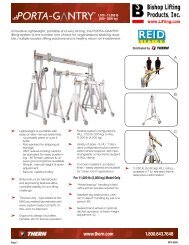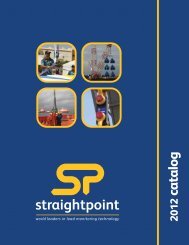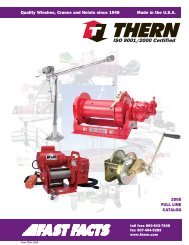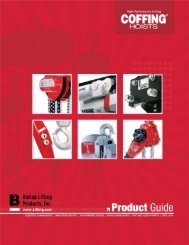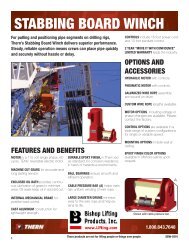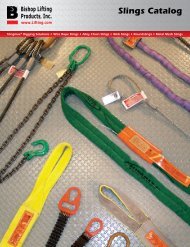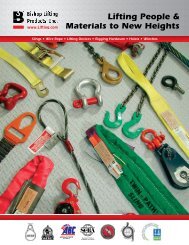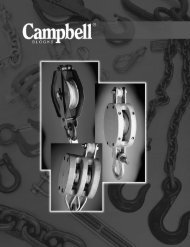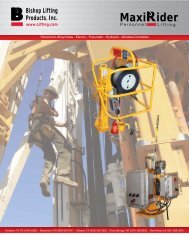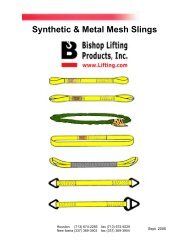warning - Bishop Lifting Products, Inc.
warning - Bishop Lifting Products, Inc.
warning - Bishop Lifting Products, Inc.
You also want an ePaper? Increase the reach of your titles
YUMPU automatically turns print PDFs into web optimized ePapers that Google loves.
Technical Information<br />
Basic Lift Engineering<br />
Every Lift Uses 1 of 3 Basic Hitches<br />
STRAIGHT OR VERTICAL, attachment,<br />
is simply using a sling to connect a lifting<br />
hook to a load. Full rated lifting capacity of<br />
the sling may be utilized, but must not be<br />
exceeded. Whenever a single sling is used in<br />
this manner, a tagline should be used to pre-<br />
vent load rotation which may cause damage<br />
to the sling.<br />
When two or more slings are attached to<br />
the same lifting hook in straight or vertical,<br />
manner, the total hitch becomes, in effect,<br />
a lifting bridle, and the load is distributed<br />
among the individual slings.<br />
CHOKER hitches reduce lifting capability<br />
of a sling, since this method of rigging affects<br />
ability of the wire rope components to<br />
adjust during the lift. A choker is used when<br />
the load will not be seriously damaged by<br />
the sling body—or the sling damaged by the<br />
load, and when the lift requires the sling to<br />
snug up against the load.<br />
As the horizontal angle between the legs of a sling decreases,<br />
the load on each leg increases. The effect is the same whether a<br />
single sling is used as a basket or two slings are used with each<br />
in a straight pull, as with a 2-legged bridle.<br />
Anytime pull is exerted at an angle on a leg—or legs—of a<br />
sling, the load per leg can be determined by using the data in<br />
the table at right. Proceed as follows to calculate this load—and<br />
determine the rated capacity required of the sling or slings,<br />
needed for a lift.<br />
1. First, divide the total load to be lifted by the number of legs<br />
to be used. This provides the load per leg if the lift were<br />
being made with all legs lifting vertically.<br />
2. Determine the angle.<br />
Basic Lift Engineering<br />
The diameter of the bend where the sling<br />
contacts the load should keep the point<br />
of choke against the sling BODY — never<br />
against a splice or the base of the eye. When<br />
a choke is used, the sling rated capacity must<br />
be adjusted downward to compensate for loss<br />
of capability.<br />
A choker hitch should be pulled tight before<br />
a lift is made — NOT PULLED DOWN<br />
DURING THE LIFT. It is also dangerous to<br />
use only one choker hitch to lift a load which<br />
might shift or slide out of the choke.<br />
BASKET hitches distribute a load between<br />
the two legs of a sling — within limitations<br />
described below. Capacity of a sling used in a<br />
basket is affected by the bend or curvature,<br />
where the sling body comes in contact with<br />
the load— just as any sling is affected and<br />
limited by bending action, as over a sheave.<br />
STRAIGHT<br />
LOAD<br />
CHOKER<br />
Calculating the Load on Each Leg of a Sling<br />
LOAD<br />
BASKET<br />
LOAD<br />
3. Then MULTIPLY the load per leg (as computed in No. 1<br />
above) by the Load Factor for the leg angle being used<br />
(from the table at right) – to compute the ACTUAL LOAD<br />
on each leg for this lift and angle. THE ACTUAL LOAD<br />
MUST NOT EXCEED THE RATED SLING CAPACITY.<br />
Thus, in drawing three (sling angle at 60°): 1000 / 2=500<br />
(Load Per Leg if a vertical lift)<br />
500 x 1.154=577 lbs. = ACTUAL LOAD on each leg at the 60°<br />
HORIZ angle being used.<br />
In drawing four (sling angle of 45°):<br />
1000 / 2=500 (Load Per Leg if a vertical lift)<br />
500 x 1.414=707 lbs. = ACTUAL LOAD on each leg at the 45°<br />
HORIZ angle being used.<br />
500 LBS.<br />
90° 75°<br />
60°<br />
1000 LBS.<br />
500 LBS.<br />
518 LBS.<br />
1000 LBS.<br />
1000 LBS.<br />
518 LBS.<br />
577 LBS.<br />
1000 LBS.<br />
1000 LBS.<br />
577 LBS.<br />
707 LBS.<br />
1000 LBS.<br />
45°<br />
1000 LBS.<br />
707 LBS.<br />
LEG<br />
ANGLE<br />
(Degrees)<br />
LOAD<br />
FACTOR<br />
90° 1.000<br />
85° 1.003<br />
80° 1.015<br />
75° 1.035<br />
70° 1.064<br />
65° 1.103<br />
60° 1.154<br />
55° 1.220<br />
50° 1.305<br />
45° 1.414<br />
(800) 972-1041 Technical Information 137



